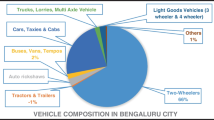Abstract
A dynamic offset with coordinated signal control system (DYCCS) was developed in this study. When configuring the DYCCS, the Critical Intersection (CI) of a coordinated corridor was operated based on saturation equalization signal control, and the adjacent intersections were controlled by coordinated semi-actuated signal control, with the background cycle corresponding to the suggested cycle length of the CI. An algorithm for the dynamic offset was suggested to integrate in the coordinated semi-actuated signal control algorithm and the saturation equalization signal control algorithm. Moreover, simulations were conducted for pre-timed signal control using one or three optimized signal timings and the DYCCS. The simulations demonstrated that the DYCCS can decrease the average vehicle delay relative to an optimized time of day and a Coordinated Signal Control System (CCS) utilizing a fixed offset. It is anticipated that the implementation of this DYCCS in newly constructed intersections or existing intersections controlled by a pretimed signal control may significantly decrease vehicle delay and may enhance progression effects in a coordinated corridor. A local controller equipped with this algorithm combined with an existing traffic responsive control, such as COSMOS, would be efficient under various conditions.
Similar content being viewed by others
References
Abbas, M. and Bullock, D. (2002). “Real-time offset tuning: Motivation, findings and lessons learned.” Transportation Research Board 81st Annual Meeting (CD-Rom), Washington, D.C.
Abbas, M., Bullock, D., and Head, L. (2001). “Real-time offset transitioning algorithm for coordinating traffic signals.” Transportation Research Record No. 1748, Transportation Research Board, Washington, D.C., pp. 26–39, DOI: 10.3141/1748-04.
Kim, J. T., Chang, M. S., and Park, J. W. (2005). “A comparison study of different offset transition lengths in simulation environment.” J. Korean Soc. Transp., Vol. 23, No. 7, pp. 43–52.
Kim, J. W. (2007). Evaluation of COSMOS TRC using the CORSIM RTE (Run-Time Extension), MSc Thesis, University of Seoul, Seoul, Korea.
KoROAD (1991). Development of COSMOS, Seoul Metropolitan, Korea.
Lee, C. Y., Kim, J. T., and Chang, M. S. (2004). “Development of neural network based cycle length model minimizing delay for traffic responsive control.” J. Korean Soc. Transp., Vol. 22, No. 3, pp. 145–157.
Seoul Metropolitan Police Agency (2001). COSMOS Development Plan of Seoul, Seoul, Korea.
Seoul Metropolitan Police Agency (2001). Real-time traffic signal control system COSMOS.
Shoup, G. E. and Bullock, D. (1999). “Dynamic offset tuning procedure using travel time data.” Transportation Research Record No. 1683, Transportation Research Board, Washington, D.C., pp. 84–94, DOI: 10.3141/1683-11.
The Korea Transport Institute (2004). Development of a traffic signal controller enhancing traffic operations and safety in rural signalized intersections, MLTM, Korea.
The Korea Transport Institute (2008). Development of wireless interface signal control systems for dynamic and optimum management (WISDOM), MLTM, Korea.
Tsay, H. S. and Lin, L. T. (1988). “A new algorithm of for solving the maximum progression bandwidth.” Transportation Research Record 1194, Transport Research Board, National Research Council, Washington, D.C., pp. 15–30.
Webster, F. V. (1958). “Traffic signal setting.” Road Research Technical Paper, No. 39, London, HMSO.
Webster, F. V. and Cobbe, B. M. (1966). “Traffic signals.” Road Research Technical Paper, No. 56, London, HMSO.
Yin, Y., Li, M., and Skabardonis, A. (2007). “Offline offset refiner for coordinated actuated signal control systems.” J. Transp. Eng., Vol. 133, No. 7, pp. 423–432, DOI: 10.1061(ASCE)0733-947X(2007)133:7(423).
Author information
Authors and Affiliations
Corresponding author
Rights and permissions
About this article
Cite this article
Park, SY., Kim, DN., Lee, SK. et al. Development of a dynamic offset with coordinated signal control system for rural corridors. KSCE J Civ Eng 20, 421–430 (2016). https://doi.org/10.1007/s12205-015-0729-x
Received:
Revised:
Accepted:
Published:
Issue Date:
DOI: https://doi.org/10.1007/s12205-015-0729-x




